Exploring Emerging Technologies with Analysis of Bibliographic Data Focused on Plasma Surface Treatment
Abstract
:1. Introduction
2. Methodology
2.1. The Overview of Data Analysis
2.2. How to Explore Emerging Tecnologies
3. Results and Discussion
3.1. Research Trends of Plasma Surface Treatment
3.2. Analysis of the Results of Exploring Emerging Technologies
4. Conclusions
Funding
Institutional Review Board Statement
Informed Consent Statement
Data Availability Statement
Conflicts of Interest
References
- Taylor, W. Technical Synopsis of Plasma Surface Treatments; University of Florida: Gainesville, FL, USA, 2009. [Google Scholar]
- Small, H.; Boyack, K.W.; Klavans, R. Identifying emerging topics in science and technology. Res. Policy 2014, 43, 1450–1467. [Google Scholar] [CrossRef]
- Chen, C.; Hu, Z.; Liu, S.; Tseng, H. Emerging trends in regenerative medicine: A scientometric analysis in CiteSpace. Expert Opin Biol Ther. 2012, 12, 593–608. [Google Scholar] [CrossRef] [PubMed]
- Wang, Q. A bibliometric model for identifying emerging research topics. J. Assoc. Inf. Sci. Technol. 2018, 69, 290–304. [Google Scholar] [CrossRef] [Green Version]
- Vaseashta, A. Advanced sciences convergence based methods for surveillance of emerging trends in science, technology, and intelligence. Foresight 2014, 16, 17–36. [Google Scholar] [CrossRef]
- Small, H. Tracking and predicting growth areas in science. Scientometrics 2006, 68, 595–610. [Google Scholar] [CrossRef] [PubMed] [Green Version]
- Upham, S.; Small, H. Emerging research fronts in science and technology: Patterns of new knowledge development. Scientometrics 2010, 83, 15–38. [Google Scholar] [CrossRef] [PubMed]
- Huang, J.; Peng, M.; Wang, H.; Cao, J.; Gao, W.; Zhang, X. A probabilistic method for emerging topic tracking in microblog stream. World Wide Web 2017, 20, 325–350. [Google Scholar] [CrossRef]
- Manaskasemsak, B.; Chinthanet, B.; Rungsawang, A. Graph clustering-based emerging event detection from twitter data stream. In Proceedings of the Fifth International Conference on Network, Communication and Computing, Kyoto, Japan, 17–21 December 2016; pp. 37–41. [Google Scholar]
- Smith, J.; Ward, D.; Michaelides, M.; Moore, A.T.; Simpson, S. New and emerging technologies for the treatment of inherited retinal diseases: A horizon scanning review. Eye 2015, 29, 1131–1140. [Google Scholar] [CrossRef] [PubMed]
- Cozzens, S.E.; Gatchair, S.; Kang, J.; Kim, K.-S.; Lee, H.J.; Ordóñez, G.; Porter, A. Emerging technologies: Quantitative identification and measurement. Technol. Anal. Strateg. Manag. 2010, 22, 361–376. [Google Scholar] [CrossRef]
- Rotolo, D.; Rafols, I.; Hopkins, M.; Leydesdorff, L. Scientometric mappings as strategic intelligence for tentative governance of emerging science and technologies. SPRUWorking Pap. Ser. 2014, 10, 1–40. [Google Scholar]
- Kim, Y.; Park, J.; Yang, S. Alldevelop, Research on Emerging Issue Analysis and Online Platform Development; Research Report 20–15; National Assembly Futures Institute: Seoul, Korea, 2020. [Google Scholar]
- Shao, T.; Zhang, C.; Long, K.; Zhang, D.; Wang, J.; Yan, P.; Zhou, Y. Surface modification of polyimide films using unipolar nanosecond-pulse DBD in atmospheric air. Appl. Surf. Sci. 2010, 256, 3888–3894. [Google Scholar] [CrossRef]
- Tan, S.H.; Nguyen, N.T.; Chua, Y.C.; Kang, T.G. Oxygen plasma treatment for reducing hydrophobicity of a sealed polydimethylsiloxane microchannel. Biomicrofluidics 2010, 30, 4. [Google Scholar] [CrossRef] [PubMed] [Green Version]
- Chen, J.P.; Su, C.H. Surface modification of electrospun PLLA nanofibers by plasma treatment and cationized gelatin immobilization for cartilage tissue engineering. Acta Biomater. 2011, 7, 234–243. [Google Scholar] [CrossRef] [PubMed]
- Yoshida, S.; Hagiwara, K.; Hasebe, T.; Hotta, A. Surface modification of polymers by plasma treatments for the enhancement of biocompatibility and controlled drug release. Surf. Coat. Technol. 2013, 233, 99–107. [Google Scholar] [CrossRef]
- Vesel, A.; Mozetic, M. Surface modification and ageing of PMMA polymer by oxygen plasma treatment. Vacuum 2012, 86, 634–637. [Google Scholar] [CrossRef]
- Bárdos, L.; Baránková, H. Cold atmospheric plasma: Sources, processes, and applications. Thin Solid Film. 2010, 518, 6705–6713. [Google Scholar] [CrossRef]
- Pinto, S.; Alves, P.; Matos, C.M.; Santos, A.C.; Rodrigues, L.R.; Teixeira, J.A.; Gil, M.H. Poly(dimethyl siloxane) surface modification by low pressure plasma to improve its characteristics towards biomedical applications. Colloids Surf. B Biointerfaces 2010, 81, 20–26. [Google Scholar] [CrossRef] [PubMed] [Green Version]
- Kostov, K.G.; Nishime, T.; Castro, A.H.R.; Toth, A.; Rogerio, H. Surface modification of polymeric materials by cold atmospheric plasma jet. Appl. Surf. Sci. 2014, 314, 367–375. [Google Scholar] [CrossRef] [Green Version]
- Jokinen, V.; Suvanto, P.; Franssila, S. Oxygen and nitrogen plasma hydrophilization and hydrophobic recovery of polymers. Biomicrofluidics 2012, 6, 016501. [Google Scholar] [CrossRef] [PubMed] [Green Version]
- Chen, M.; Zhang, Y.; Sky Driver, M.; Caruso, A.N.; Yu, Q.; Wang, Y. Surface modification of several dental substrates by non-thermal, atmospheric plasma brush. Dent. Mater. 2013, 29, 871–880. [Google Scholar] [CrossRef] [PubMed] [Green Version]
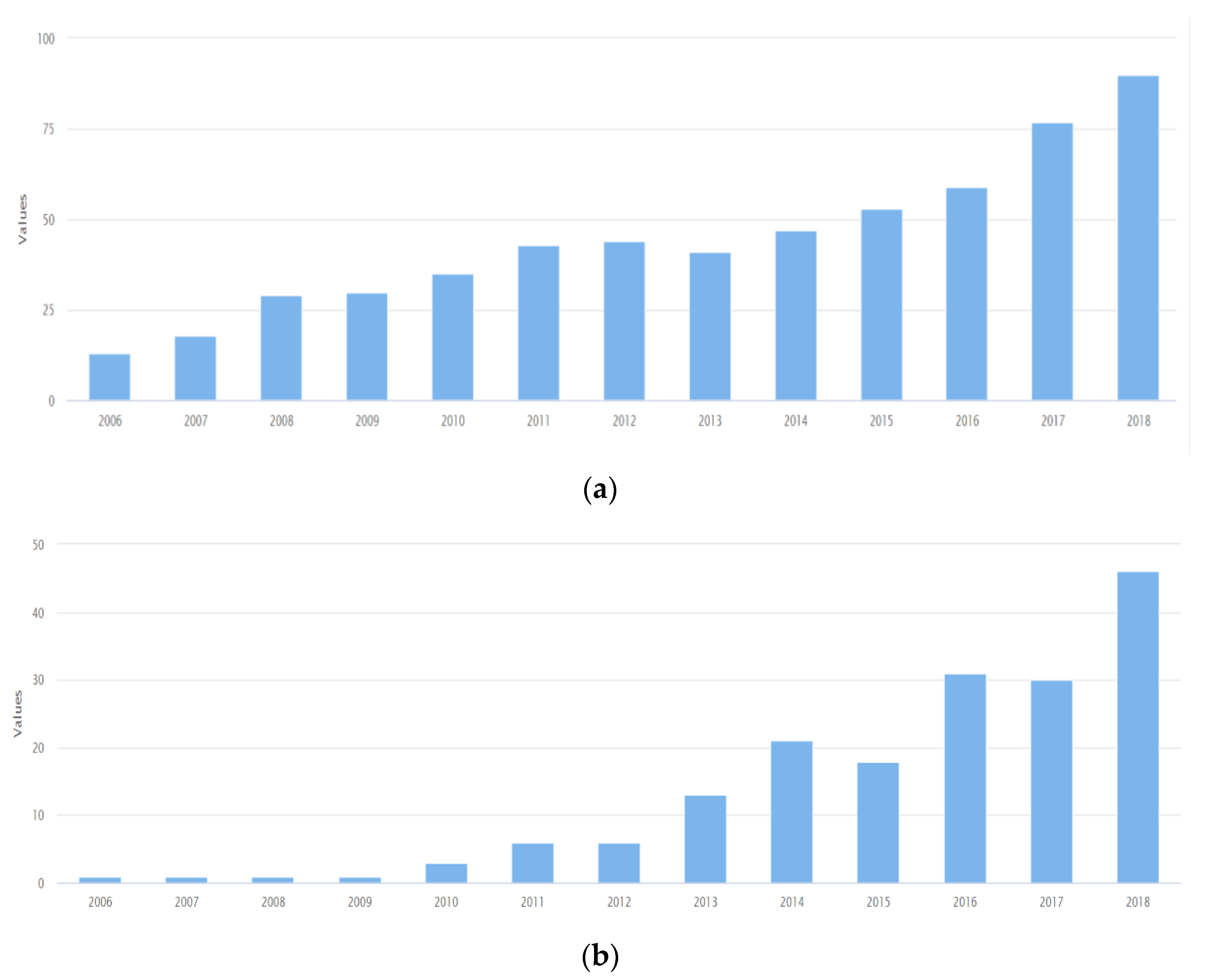
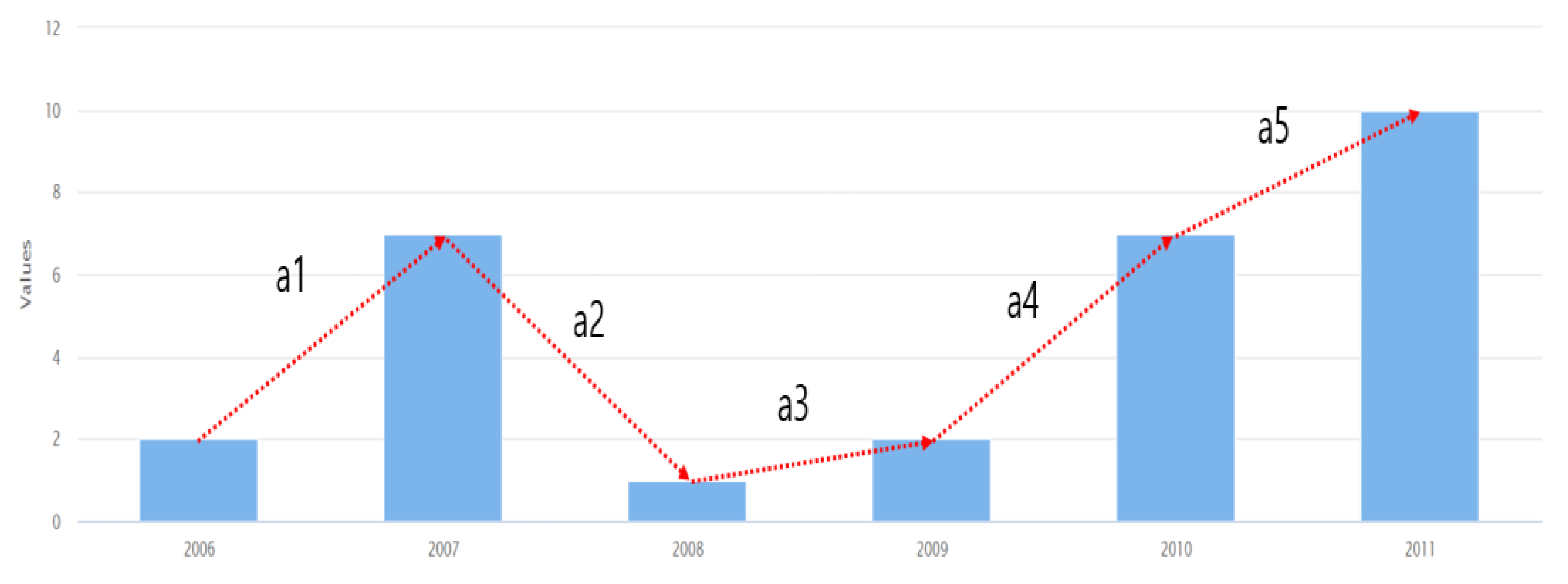
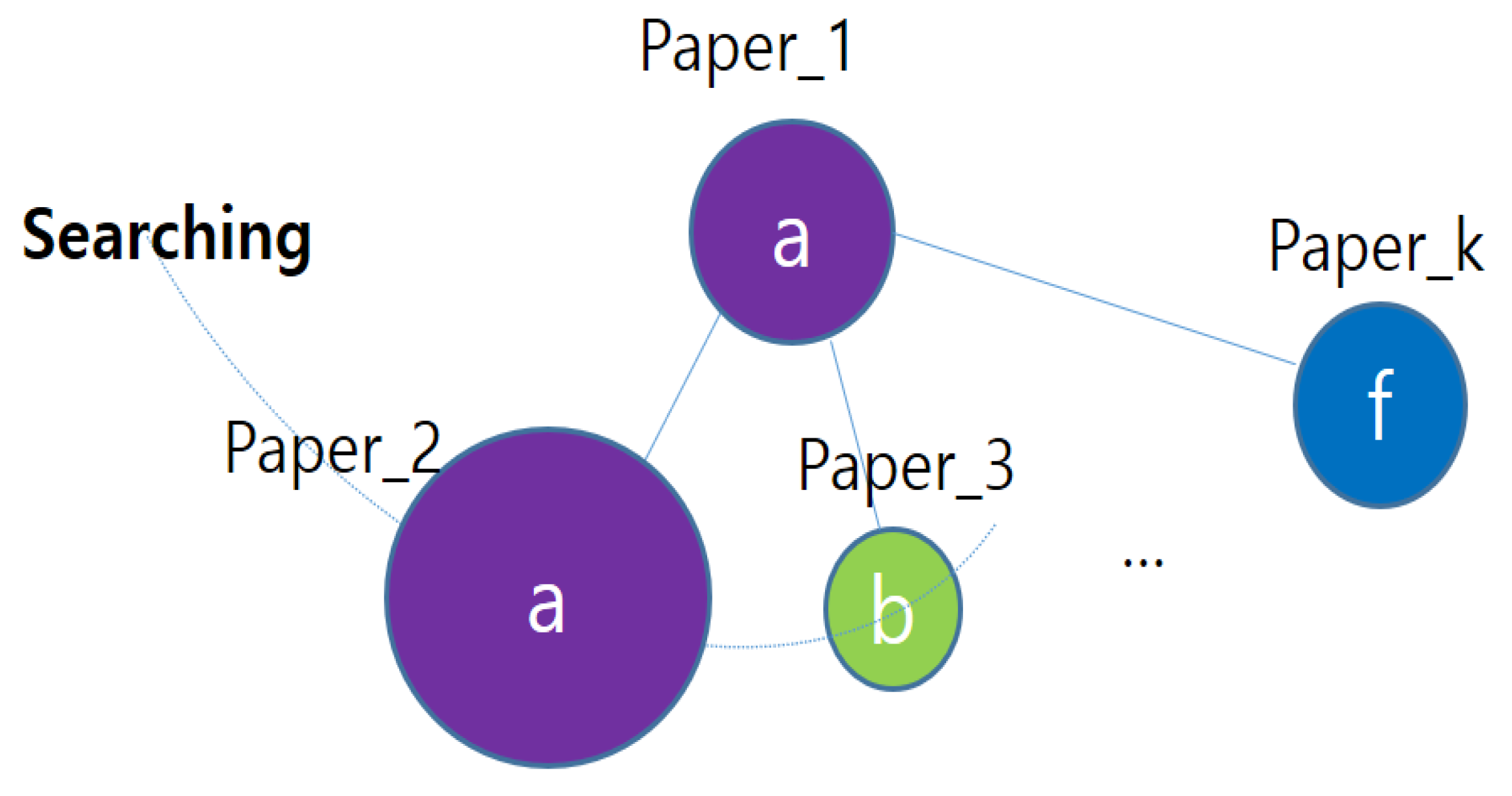

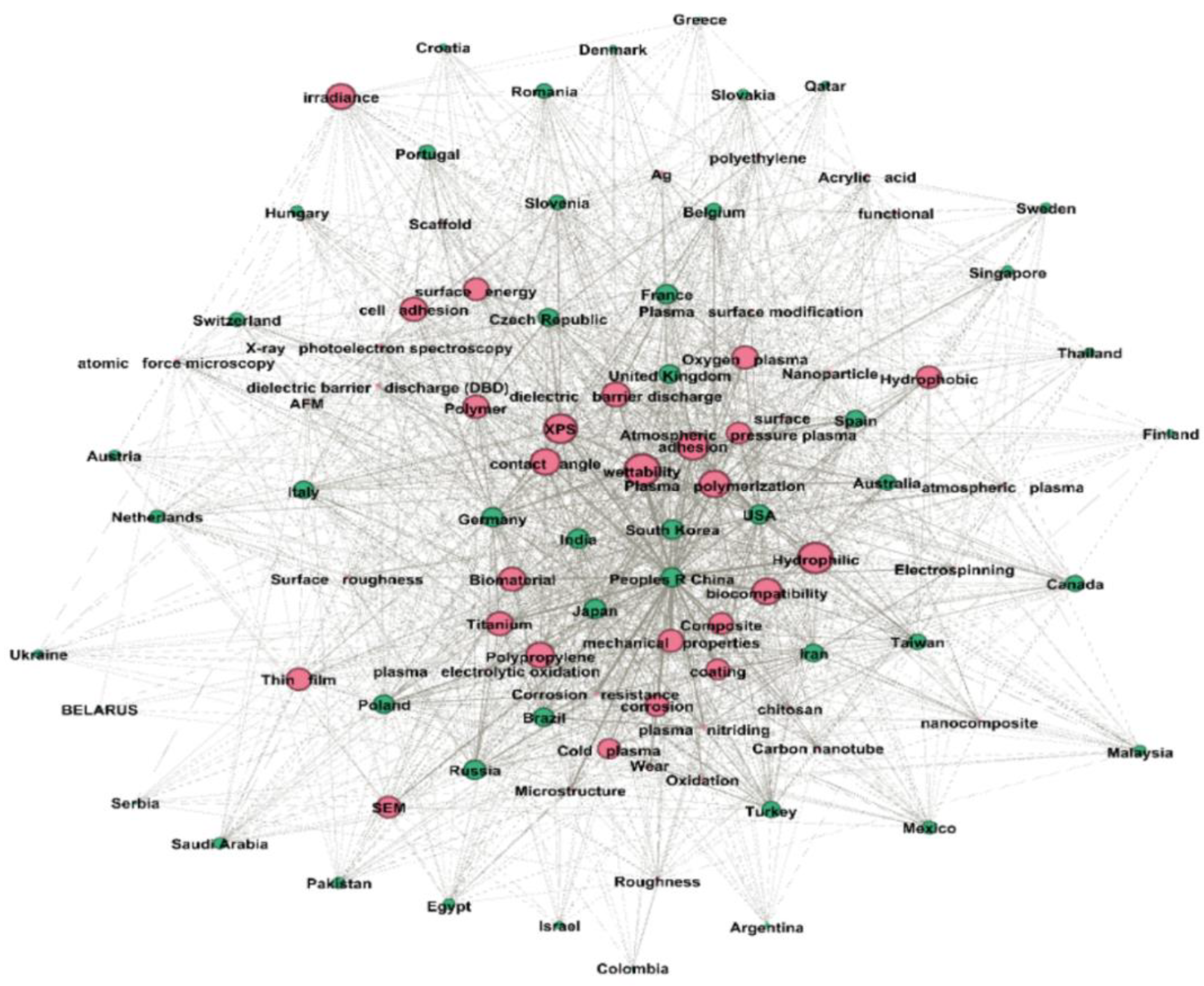
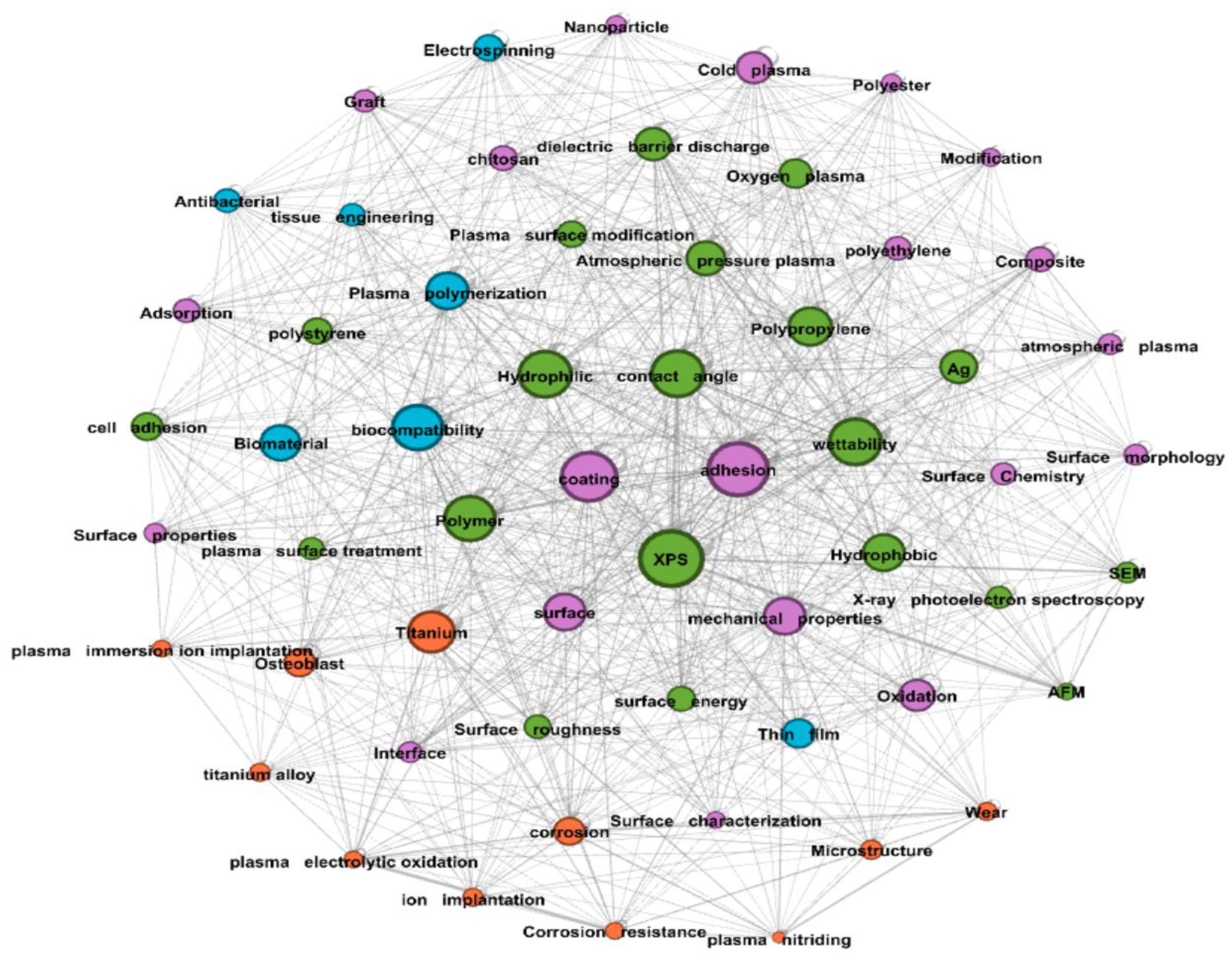
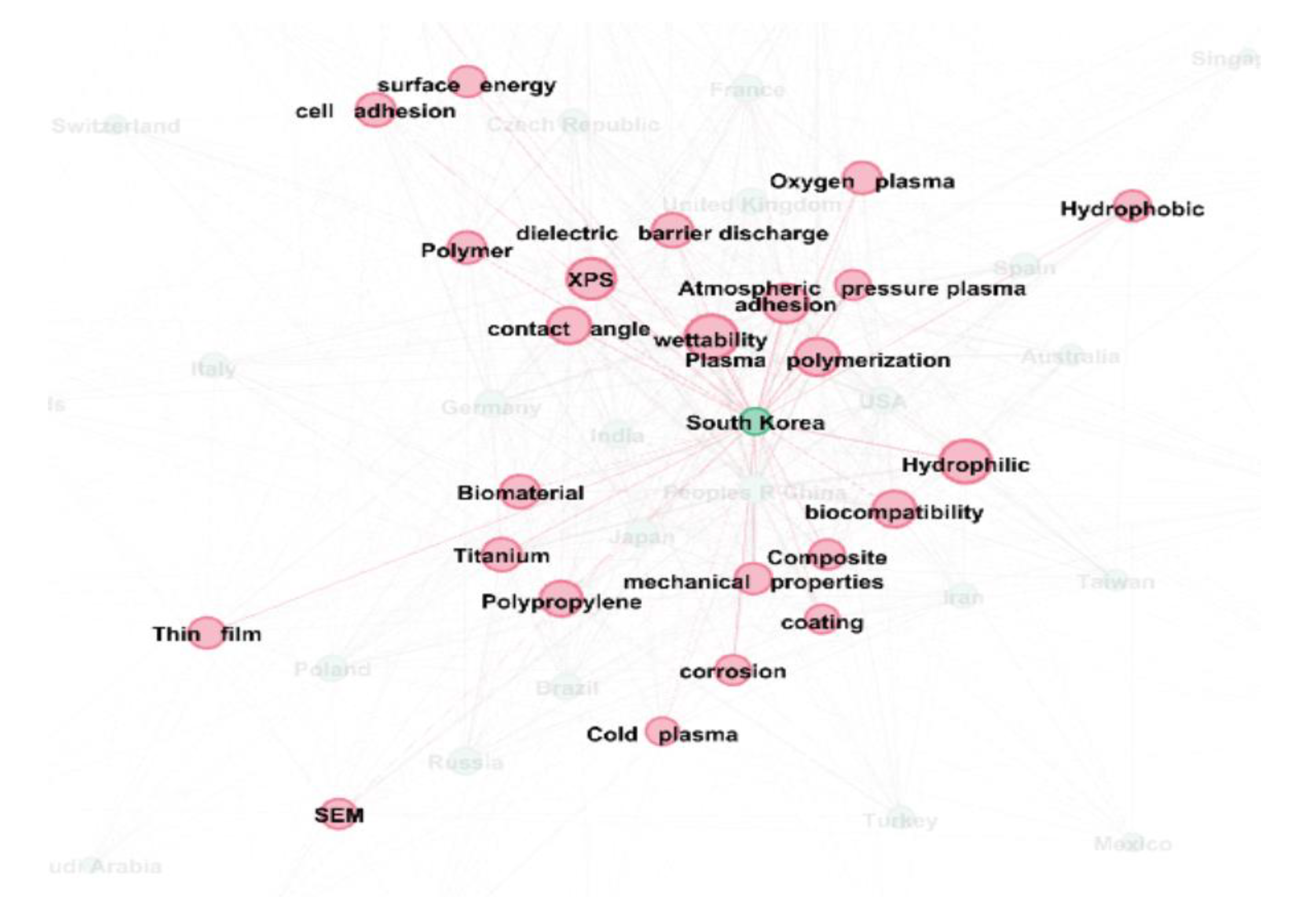
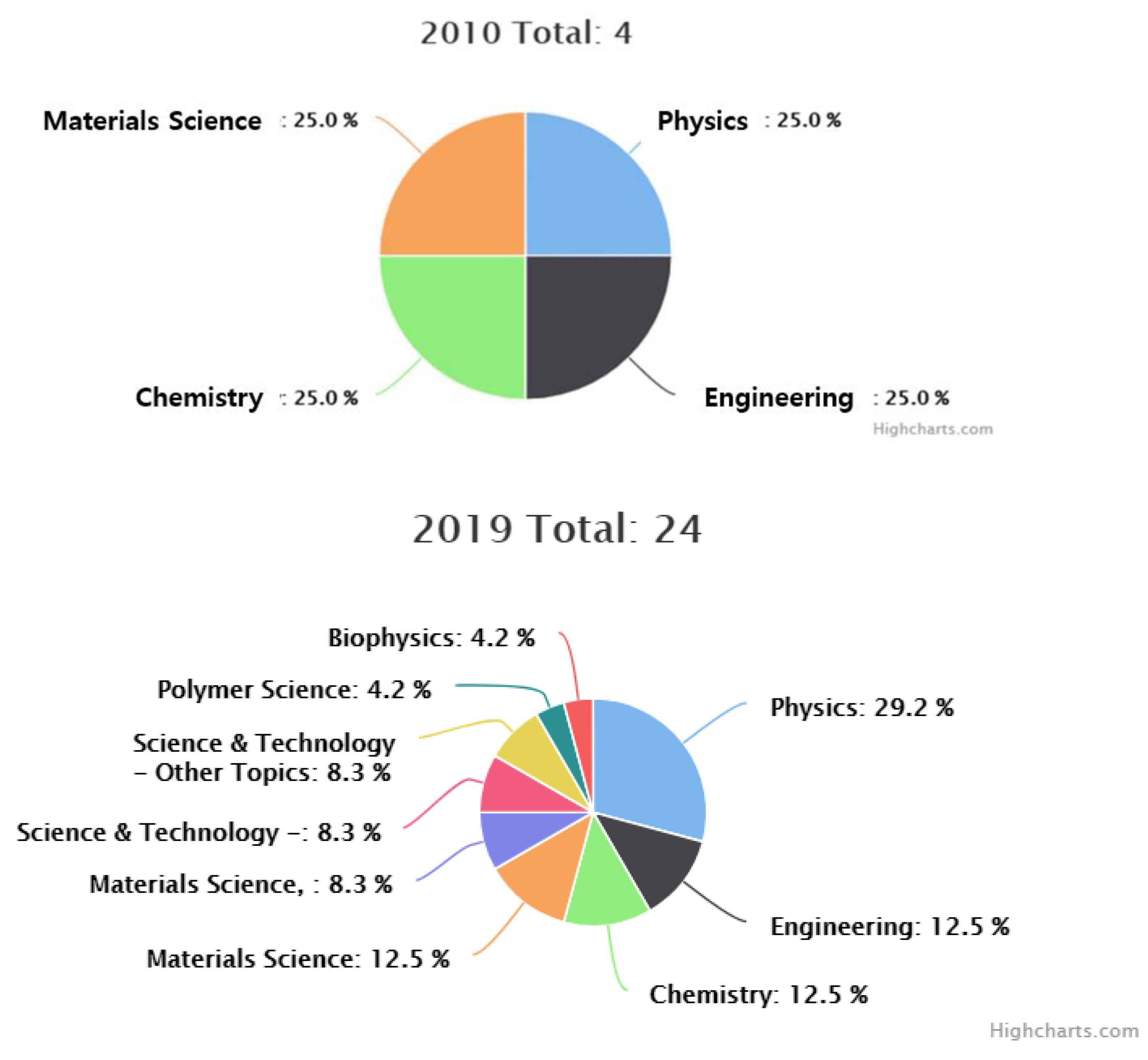
| Rank | Keywords | Rank | Keywords |
|---|---|---|---|
| 1 | Corrosion resistance | 21 | Microfabrication |
| 2 | Plasma materials processing | 22 | Bioactivity |
| 3 | Carbon fiber | 23 | Epoxy |
| 4 | Microhardness | 24 | Spark plasma sintering |
| 5 | Nanofibers | 25 | Biofouling |
| 6 | Antibacterial activity | 26 | Epoxy resin |
| 7 | Interfacial adhesion | 27 | Friction |
| 8 | Additive manufacturing | 28 | Surface activation |
| 9 | Atmospheric-pressure plasma jet | 29 | Bone tissue engineering |
| 10 | Shear bond strength | 30 | Biofilm |
| 11 | Microstructure | 31 | Polydimethylsiloxane (PDMS) |
| 12 | EIS | 32 | Air plasma |
| 13 | Dental implant | 33 | DBD plasma |
| 14 | Fatigue strength | 34 | Diamond-like carbon |
| 15 | Bipolar plate | 35 | Cytocompatibility |
| 16 | Surface morphology | 36 | Niobium |
| 17 | Polypyrrole | 37 | Bioactive coating |
| 18 | Transmission electron microscopy | 38 | Superhydrophobicity |
| 19 | CFRP | 39 | Nanoindentation |
| 20 | Graphene oxide | 40 | Silver nanoparticles |
| Rank | Paper | # of Citations |
|---|---|---|
| 1 | “Surface modification of polyimide films using unipolar nanosecond-pulse DBD in atmospheric air” (2010) | 157 |
| 2 | “Oxygen plasma treatment for reducing hydrophobicity of a sealed polydimethylsiloxane microchannel” (2010) | 121 |
| 3 | “Surface modification of electrospun PLLA nanofibers by plasma treatment and cationized gelatin immobilization for cartilage tissue engineering” (2011) | 118 |
| 4 | “Surface modification of polymers by plasma treatments for the enhancement of biocompatibility and controlled drug release” (2013) | 86 |
| 5 | “Surface modification and ageing of PMMA polymer by oxygen plasma treatment” (2012) | 88 |
| 6 | “Cold atmospheric plasma: Sources, processes and applications” (2010) | 88 |
| 7 | “Poly (dimethyl siloxane) surface modification by low pressure plasma to improve its characteristics towards biomedical applications” (2010) | 128 |
| 8 | “Surface modification of polymeric materials by cold atmospheric plasma jet” (2014) | 74 |
| 9 | “Oxygen and nitrogen plasma hydrophilization and hydrophobic recovery of polymers” (2012) | 61 |
| 10 | “Surface modification of several dental substrates by non-thermal, atmospheric plasma brush” (2013) | 56 |
| Emerging Keywords | Keywords of Propagated Fields |
|---|---|
| Antibacterial activity | X-ray photoelectron spectroscopy, Double langmuir probe, Plasma density, Electron temperature, Debye length, Hydrogen, nitrogen plasma, Poly (ethylene terephthalate), Functional groups, Poly (lactic acid), Tin, Catalyst residuals, Fluorimetry, Polystyrene, CF4 plasma, Surface functionalization, Hydrophobization, Fluorination, XPS, Ps polymer, Endothelia cells, Platelets, Vascular grafts, Biocompatibility, Super-hydrophilicity, Regenerated non-woven cellulose, Oxygen, Mechanical properties, Model system, Wound dressings, AFM, Force spectroscopy, Polymer materials, Optical emission spectroscopy, Oxygen plasma, Functional groups, Graphite, Polystyrene, Protein adsorption, Hos cell proliferation, Printability, Fluoroquinolone, Low-density polyethylene, Wettability, Polymer polypropylene, Neutral oxygen atom density, Initial surface Functionalization, Food packaging, Antimicrobial activity, Active packaging, Gallic acid. |
| Interfacial adhesion | Air DBD plasma, Surface free energy, Tensile strength, Armos fibers, Wettability, DBD plasma, PBO fiber, Surface analysis, Surface characterization, Wetting behavior, Aramid fiber, Treatment time, Fiber tensile strength, Interface properties, PBO/PPESK composite, Carbon compounds, Electrochemistry, Conducting polymers, Properties and characterization, Functionalization of polymers, Textiles, Interfacial shear strength, Multiscale hybrid fibre, Graphene oxide, Plasma polymerization, Polymer-matrix composites (PMCS), Textile composites, Mechanical properties, Adhesion, Reduced graphene oxide, Polyester, Conductive fabrics, Interface modification, Single-fiber fragmentation, Orthogonal experiment, Surface free energy, Para-aramid, thermogravimetric analysis, Low-pressure RF plasma treatment, FTIR spectroscopy, Specific strength, Meta-aramid, Differential scanning calorimetry, Waste plastic bags, Plywood. |
| Atmospheric-pressure plasma jet | Optical emission spectra, Water contact angle (WCA), Treatment distance, Gas discharge, Discharge power density, Polyethylene terephthalate (PET), Polymer surface modification, Wettability, Low molecular weight oxidized material, Dielectric barrier discharge, Hydrophilic modification, Microsecond pulse, Gas discharge, Flashover voltage, Pulsed discharge, Surface flashover, Non-thermal plasma, Pulsed power, Surface charge dissipation, Surface trap, Atmospheric-pressure dielectric barrier discharge, Self-healing, bond pull strength, Polytetrafluoroethylene (PTFE), Solder float test, Microwave laminate, Plated through hole, X-ray photoelectron spectroscopy, Absorption spectroscopy, Silicone rubber, Combined voltage, Converter station, Flashover performance, Nacre, UV radiation, Polymer tube, Hydrophilization, Atmospheric cold plasma, Homogeneous, Flexible plasma jet, Ros distribution, tilted application, Triboelectric nanogenerator, Power output enhancement, O-2 and AR plasma, two-step plasma etching, CF4 free. |
| Dental implant | Ceramic adhesion, Precursor monomer, Non-thermal atmospheric pressure plasma, Surface characterization, Plasma adhesion, Hydrophilic, Dental wax, Surfactant free, Dielectric barrier discharge (DBD), Polymer-matrix composites (PMCS), Textile composites, Plasma process, IR spectra, Hap, Polyethylene terephthalate, Candida albicans, Early adherence, Heat-polymerized Acrylic resin, Contact angle, Biofilm, Osteoblast, Titanium, Self-adhesive resin cement, Shear bond strength, Micromechanical retention, Implant-abutment surface, Provisional cement retention, Abutment surface modification, RGD peptide, Cell adhesion and proliferation, Fibroblast, Ethanol, Octenidine, Abutment, Chlorhexidine, Zirconia ceramic, UV light, Photofunctionalization, Implant surface, Xenograft, Bone regeneration, Argon, Bovine bone, Hydroxyl groups, Anodization, Superhydrophobicity, Hydrogen peroxide, Mechanized surface, Bone-to-implant contact, Resorbable blast media surface, Osseointegration, Implant dentistry, Raman spectroscopy, Anatase, Surface roughness, Ce-stabilised zirconia, Alumina nanocomposite, Bone, Mechanized surface, Anatase, TiO2, ROS assay, QCM measurement. |
| Surface morphology | Atmospheric pressure plasma jet, Wettability, Low molecular weight oxidized material, Dielectric barrier discharge, Non-woven fabric, Sonophotocatalysis, Ag nanoparticles, Corona discharge, TiO2 nanoparticles, Polypropylene, Aluminium alloy, Adhesion tape test, Air drag force, Tail gas component, Flow humidity, DBD remote treatment, Pet yarn, Oxygen content, In situ xps characterization, Oxygen atom fluence, Initial stages of functionalization, Time evolution of functional groups, Adhesion, Polyethylene, Laminates, Surface chemistry, Grafting polymer, Oxidative polymerization, Polymer modification, Pyrethrum extract, Polyamide, Cellulose acetate, Supercritical solvent impregnation, 3-hexylthiophene, Gliding arc, Plasma diagnostics, Gas dynamics simulations, Bombyx mori silk fibroin, Drug delivery, Core-shell nanofibers, Polypropylene membrane, Membrane distillation, HJelium plasma treatment, Zeta potential, Nanoclay, Dyeing, Nanoclay. |
| Surface activation | Atmospheric plasma treatments, Paint adhesion, Wave energy converters, Steel surfaces, Fused hollow cathodes, Osteoblast, Hydrophilic, Surface energy, Scaffold, Biphasic scaffold, Non-thermal atmospheric plasma, Wood, Wettability, Polymer, Nanosecond pulse, Dielectric barrier discharge (DBD), Nonthermal plasma, Adhesion, Metals, Contact angles, Epoxy, Discharge power density, ESCA/XPS, OH radical, DC pulse discharge, Laser-induced fluorescence (LIF), Reactivity zones, Optical emission spectroscopy, Surfatron, Raman spectroscopy, Starch, Microplasma needle set-up, Jet array, Large area processing, Electromagnetic simulation, Bone regeneration, Poly-lactic acid (PLA), Scratch resistance, Electron beam evaporation, Aluminium alloy, Adhesion tape test, He plasma, Optical spectroscopy, Spin coating, Lactic acid, Hydroxyl radicals, Colloidal lithography, Cleaning, Gelatin, Grafting, Biomolecule deposition, Collagen, Protein voltammetry, Corona discharge, Single-crystal silicon, Surface smoothing. |
| Polydimethylsiloxane (PDMS) | SEM, FTIR, PDMS elastomer, piranha, KOH, Sulfobetaine, Urinary bladder implant, AMPS, Salt deposition, Silicone, Sylgard, Hydrophobic recovery, Image analysis, AFM, Biocompatibility, XPS, Apparent contact angle, Change in the surface energy, Titanium, Self-assembled molecules (SAMS), Histidine, Leucine, Roughness, Poly (dimethylsiloxane), Oxygen plasma treatment, Pressure-sensitive adhesives, Microfluidics, Silica-like thin films, Aging, Ionic conductor, Hydrogel, Self-healing interface, Extrusion printable hydrogel, Spray dryer, Flux adhesion, Powder, Condensed matter physics, Cell proliferation, Rapid prototyping, Stability, Endothelialization, Varying crosslinking density, Bone marrow stromal cell, Long-term cell culture, Capillary microfluidics, Geometrical valves, Spin coating, Desalination, Solar still, Graphene. |
| DBD plasma | Argon plasma, Adhesive performance, Para-aramid fiber, Fibers, Interfaces, SEM, XPS, Twaron fiber, Plasma-induced coating, Polysulfonamide, Dyeability, Liquid droplet, Interfacial adhesion, Dopamine, Silane, Aramid/rubber composite, Plasma-induced coating, Paper strength, Vinyl epoxy composites, T-peel test, Woven aramid, Impact test, Adhesion pull-off test, CNF, Electric field distribution, Glow discharge, Quasi glow discharge, Polyester, Energy compression, Dischargetime-regulated power source, Polymer films, Supercritical CO2, Ionic liquid, Aromatic polyamides, Kevlar fibre, Silicone, Thermogravimetric analysis, Low-pressure RF plasma treatment, FTIR spectroscopy, Meta-aramid, Differential scanning calorimetry. |
| Superhydrophobicity | Plasma immersion ion implantation, Mesenchymal stem cells, Polytetrafluoroethylene, Osteogenic differentiation, Polylactic acid, Cell proliferation, Cell adhesion, Biomedical polymers, Biomaterials, Ti-based alloys, EPTFE, Plasma power, SLA-treated titanium, Cellular activity, Dental implant, Biocompatibility, Magnesium alloys, Genotoxicity, Bioactivity, Antibacterial, PEEK, Polydimethylsiloxane, RF plasma treatment, Protein adsorption, Sand-blasting and acid etching (SLA), DC plasma treatment, Amphoteric OH, Multi-functionalization, Covalent immobilization, YTZP (yttria stabilized tetragonal zirconia), Non-thermal biocompatible atmospheric plasma (NBP), MC3T3-EL osteoblasts, dental implants, Tribological properties, Biological and medical properties, Vascular graft. |
Publisher’s Note: MDPI stays neutral with regard to jurisdictional claims in published maps and institutional affiliations. |
© 2021 by the author. Licensee MDPI, Basel, Switzerland. This article is an open access article distributed under the terms and conditions of the Creative Commons Attribution (CC BY) license (https://creativecommons.org/licenses/by/4.0/).
Share and Cite
Kim, Y. Exploring Emerging Technologies with Analysis of Bibliographic Data Focused on Plasma Surface Treatment. Coatings 2021, 11, 1291. https://doi.org/10.3390/coatings11111291
Kim Y. Exploring Emerging Technologies with Analysis of Bibliographic Data Focused on Plasma Surface Treatment. Coatings. 2021; 11(11):1291. https://doi.org/10.3390/coatings11111291
Chicago/Turabian StyleKim, Youbean. 2021. "Exploring Emerging Technologies with Analysis of Bibliographic Data Focused on Plasma Surface Treatment" Coatings 11, no. 11: 1291. https://doi.org/10.3390/coatings11111291
APA StyleKim, Y. (2021). Exploring Emerging Technologies with Analysis of Bibliographic Data Focused on Plasma Surface Treatment. Coatings, 11(11), 1291. https://doi.org/10.3390/coatings11111291





